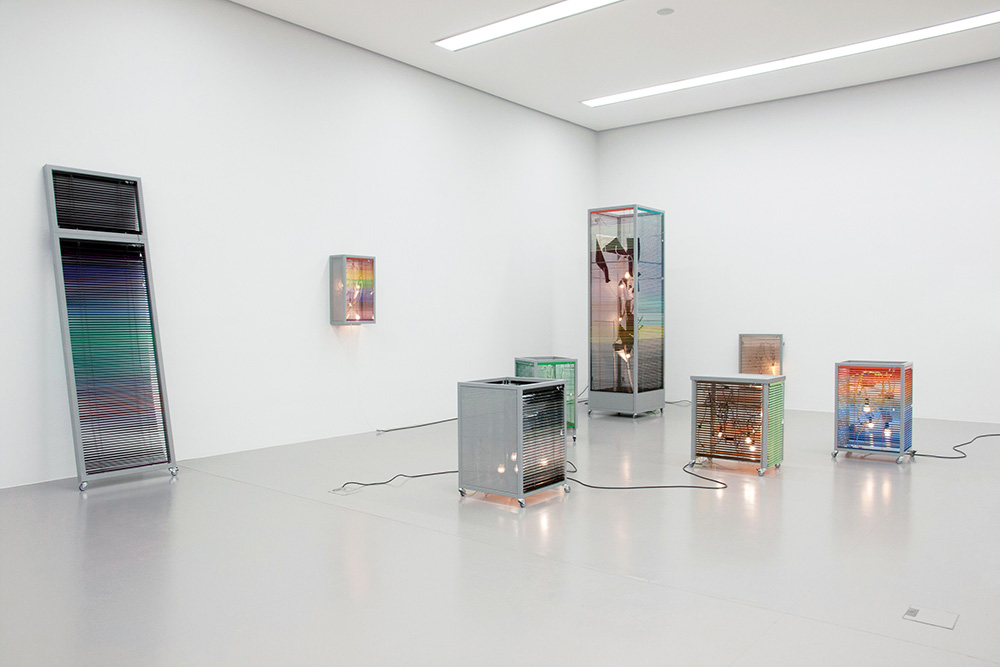ART CITIES:Cologne-Haegue Yang
 Traversing a wide range of media, from collage to performance, Haegue Yang’s body of work often features quotidian and domestic found objects ranging from tea cozies to cans of Spam. The artist dissociates such materials from their original contexts, rearranging them into abstract compositions that build upon a unique and personal visual vocabulary. By including perceptual effects generated with the help of heaters, electrical fans, and even scent diffusers, Yang frequently stages multisensory environments, which together with the mundane objects, become meditations on labor, emotional connection, and dislocation, replete with references to various moments of abstraction throughout art history.
Traversing a wide range of media, from collage to performance, Haegue Yang’s body of work often features quotidian and domestic found objects ranging from tea cozies to cans of Spam. The artist dissociates such materials from their original contexts, rearranging them into abstract compositions that build upon a unique and personal visual vocabulary. By including perceptual effects generated with the help of heaters, electrical fans, and even scent diffusers, Yang frequently stages multisensory environments, which together with the mundane objects, become meditations on labor, emotional connection, and dislocation, replete with references to various moments of abstraction throughout art history.
By Efi Michalarou
Photo: Ludwig Museum Archive
Haegue Yang is the winner of the Wolfgang Hahn Prize* for 2018, with the exhibition “ETA 1994–2018” the Museum Ludwig showcase the remarkable versatility of her entire oeuvre in Haegue Yang’s first-ever survey exhibition with over 120 works ranging from action-based objects from the 1990s to lacquer paintings, photographs, works on paper, video essays, anthropomorphic sculptures, performative pieces, and large-scale installations. The abbreviation ETA stands for “estimated time of arrival”, thus, the exhibition title points to an artistic career in transit and the constant itinerancy of an artist who maintains studios in Seoul and Berlin and has exhibited internationally since 1994. The exhibition begins with Yang’s first venetian blind installation from her series of “Vulnerable Arrangements” the “Version Utrecht” (2006), an immersive and sensorial experience unfolding from a composition of various materials and the simultaneous use of wind, scents, light, and heat. Within this arrangement, video essays document the artist’s travels through cities around the world and convey feelings of home, isolation, and dislocation associated with her itinerancy in quite personal commentaries. A central part of the exhibition is “Storage Piece” (2004). This key work was created out of financial need and an acute lack of space as a collection of packaged works on shipping pallets. The work has since been exhibited in several configurations, and its arrangement also changes at regular intervals in the Cologne exhibition. Yang’s well-known anthropomorphic light sculptures are represented with the “Medicine Men” series (2010), these consist of a variety of materials: functional and industrially manufactured everyday objects such as clothing racks, light bulbs, electric cables, and party wigs. Yang herself refers to these sculptures as “shamans” or “transvestites”, pointing to the ambiguous gender and social roles that medicine men take on in nature religions. Also on presentation are two works consisting of blinds, “Mountains of Encounter” (2008) and “Sol LeWitt Upside Down – K123456, Expanded 1078 Times, Doubled and Mirrored” (2015). For the first time, two very different types of venetian blind installations are juxtaposed in a single room: while “Mountains of Encounter” marked the beginning of a series of structurally complex compositions relating to historical events and personalities in Yang’s oeuvre, “Sol LeWitt Upside Down – K123456, Expanded 1078 Times, Doubled and Mirrored” is based on a cubic structure by the Minimalist artist Sol LeWitt, which Yang not only physically expands, but also conceptually condenses, doubles, mirrors, and finally turns upside down.
* With the Wolfgang Hahn Prize, the Gesellschaft für Moderne Kunst honours exceptional contemporary artists on an annual basis. The prize money of maximum 100.000€ goes to the acquisition of a work or group of works by the artist for the collection of the Museum Ludwig. The award winners are also honoured with an exhibition in the Museum, accompanied by a publication.
Info: Curator: Yilmaz Dziewior, Curatorial Project Management: Leonie Radine, Ludwig Museum, Heinrich-Böll-Platz, Cologne, Duration: 18/4-12/8/18, Days & Hours: Tue-Sun 10:00-18:00, www.museum-ludwig.de





